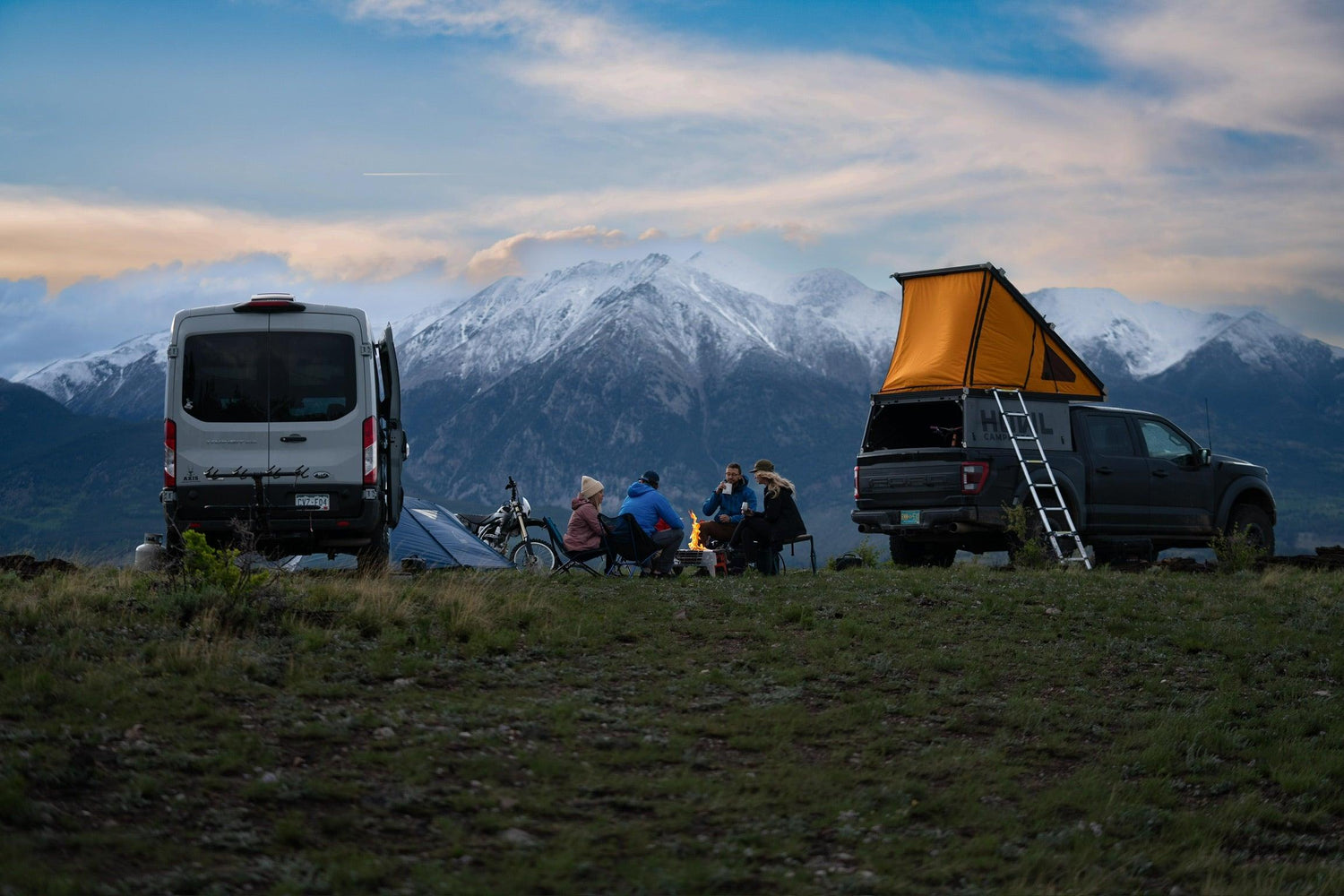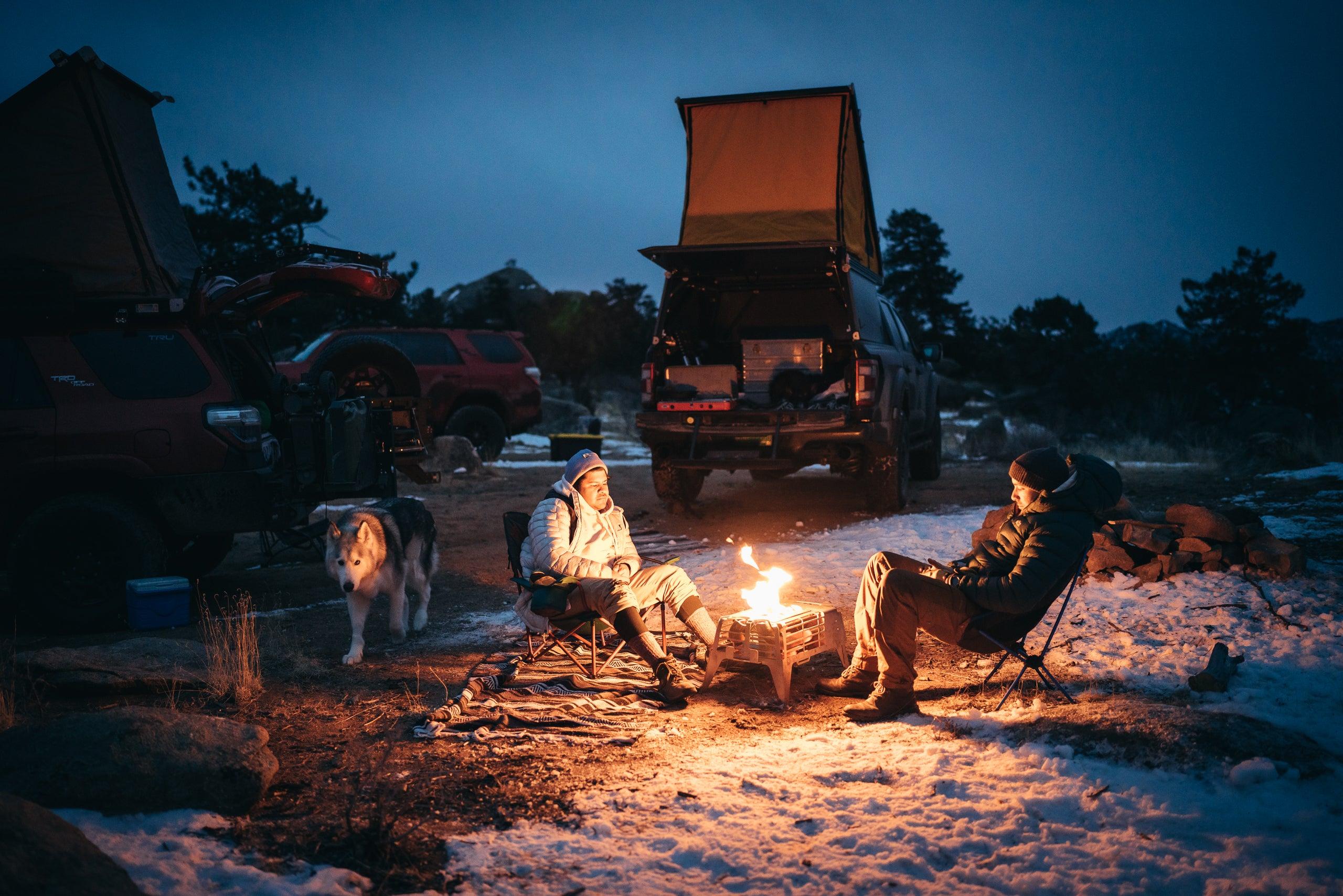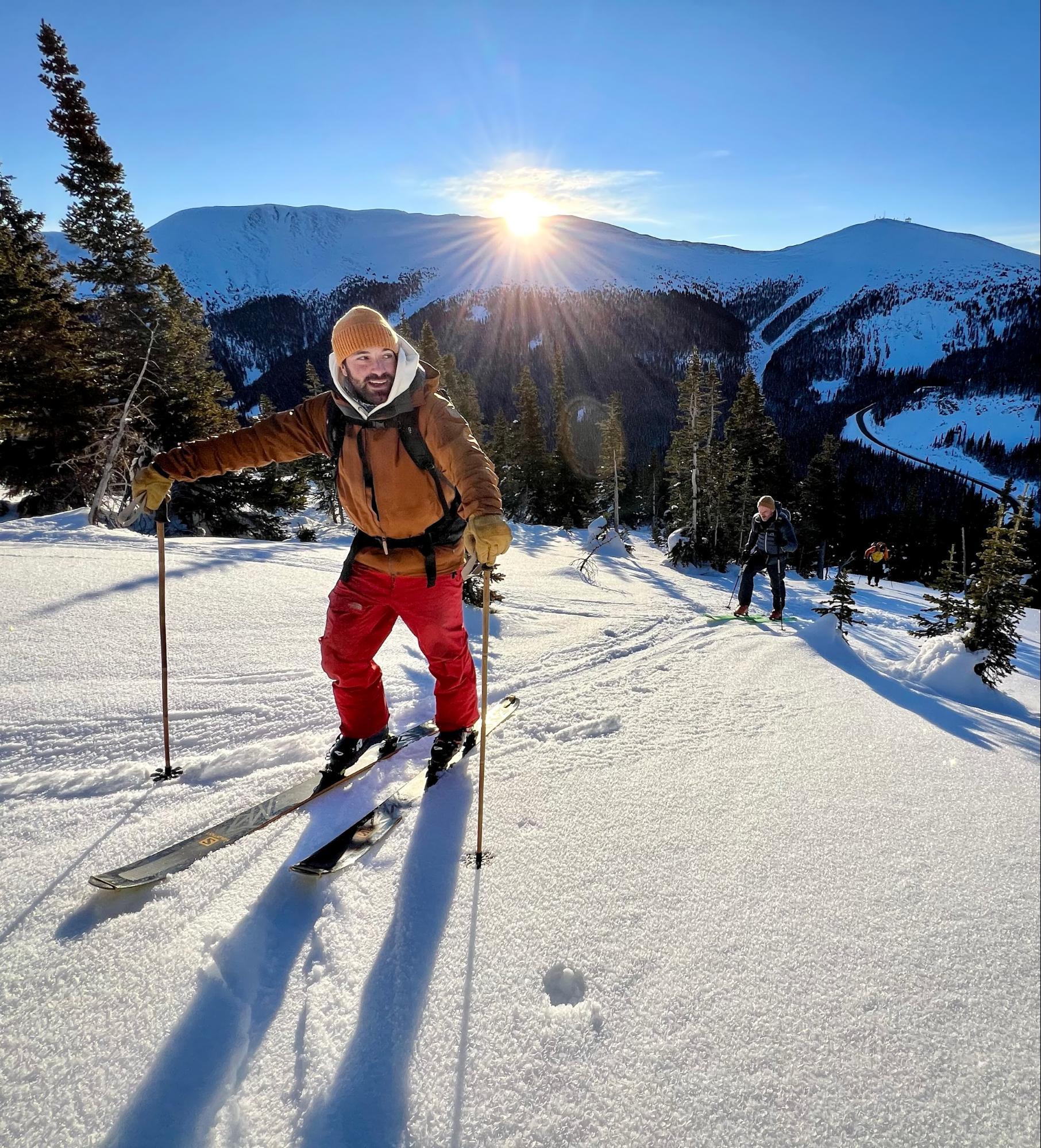Propane campfires rely on a few simple principles to make you warm. Some generate Infrared heat, while others only have flames. Some burn a ton of BTUs, while others burn less fuel. Some have lava rocks, while others don’t.
So how can you tell which propane fire pit will bring the heat?
Why Do People Use Propane Firepits?
Campers are using portable propane fire pits in record numbers, and more companies than ever are building them.
Sure, propane fires are more convenient and easier to use than wood fires. But the big reason so many campers are making the shift is because of burn bans. About 84% of wildfires are started by humans (Smithsonian), and to protect our forests, land managers frequently impose bans on burning wood and charcoal. It’s hard to know where and when these bans will be in effect, and that surprises campers, leaving them without a fire.
The solution is to camp with a portable propane fire pit. They’re allowed in most burn bans because they’re safer for forests, and propane is often the only legal way to have a fire while camping.
The Basics of Propane Fire Pits
Propane fires come in many different shapes and sizes, with different features, and at different price points. It can be difficult to know which one is right for you.
But if you know the science of how propane campfires work, you’ll be able to sift through the marketing noise and choose the fire pit that meets your needs.
Why Use Propane as a Fuel Source?
Propane is a byproduct of refining natural gas and petroleum. At high pressures like those inside a tank, the fuel is compacted into a liquid. When you let it out of the tank, it expands into a gas.
Nearly all non-wood campfires use propane because:
- It’s available nearly everywhere
- It’s easy to transport
- It packs down small
How small? Propane takes up less than half the space of firewood. A standard 20lb tank is 2 cubic feet in size, and stores roughly 430,000 BTUs of fuel energy. To get the same amount of energy with firewood, you’d have to bring along 5 cubic feet worth – roughly three standard bundles. Learn more about BTU's in this article: ARE PROPANE FIRE PITS WITH MORE BTU'S BETTER?
The Basic Components of a Propane Fire Pit
Every propane fire on the market has four essential components:
- Frame structure
- Gas-emitting burner(s)
- Fuel control knob(s)
- Fuel supply lines
The differences can be striking.
Frames – Some frames are round like bowls, which are hard to pack, while others are cube-shaped like ammo cans. Some stabilize the tank for transportation, while others leave the tank loose and rolling around. Some are rugged and strong, while others are thin and delicate.
Burners – The burners on some propane fire pits put out thigh-melting IR heat, while others only make hot air. Some reach temperatures of 1200+ºF, while others struggle to hit 550ºF. Some have built-in igniters, while others require a lighter.
Controls – The control knobs on some propane campfires are only off/on, while others offer nearly infinite micro-adjustments. However, the on/off knobs usually shut off quickly in an emergency, while the micro-adjusters often require multiple turns to stop the flow of gas.
Fuel Lines – When it comes to fuel supply lines, some are clamped rubber hoses, which leak after even mild road vibration. Others are made of steel and brass, like those found in fighter jets and F1 cars. These can handle years of hard outdoor use.
Extras – Beyond the four essential components, some fire pit makers also throw in extras like lids, stands, lava rocks, carrying totes, tank covers, and other accessories.
The Science of Heat: How do portable propane fire pits make you warm?
Not all propane fires produce warmth that transfers to the human body. You’ve probably sat around a propane fire at a hotel or restaurant and noticed that it felt a lot less warm than a wood fire of that size. That’s because flames alone can’t actually make you warm. At least not outdoors.
As you learned in grade school, there are three types of heat transfer:- Conductive: when you touch a hot surface – ex. putting your hand on a hot stove, or laying on an electric blanket.
- Convective: when warm air or liquid swirls around you – ex. sitting in a sauna or hot tub.
- Radiant: when something is so hot it glows and shoots photons at your body – ex. sitting under a hot summer sun, or next to the glowing coals of a wood fire.
Pro Tip: Trying to conduct heat into your body by touching a fire is a terrible idea and will result in severe burns. So conductive heat transfer is out. With portable propane firepits – and wood fires – you’re limited to working with the convective and radiant forms of heat transfer.
Convective Heat in Propane fire pits
All propane firepits make convective heat. Flames make hot air, and hot air transfers heat through convection. Now hot air convection works great in contained spaces like ovens, saunas, and your heated home. But when you’re outside around a campfire, there’s no way to contain the hot air. It just rises up out of your camp and blows away.
That’s why you never get warm around a traditional, flames-only propane fire pit. The only way to get its heat into your body is to position yourself into the rising stream of combustion exhaust gasses. The problems with this approach are that:- only one person can be in the exhaust gas at a time
- breathing exhaust gas is unhealthy and often leads to a headache
IR Radiant Heat in Propane fire pits
Radiant heat is effective regardless of whether you’re indoors or outside because it doesn’t heat the air. This is the kind of heat you feel when you’re around a wood fire. Wood fires have coals that glow bright orange, and that’s the light that you can see. But coals emit a much brighter light in the InfraRed spectrum, which is invisible to the human eye.
Light of every wavelength travels straight through the air, regardless of wind, temperature, or precipitation. But not every wavelength of light gets absorbed by the body as warmth. Only light at specific frequencies in the InfraRed spectrum.
When you sit next to a wood fire – or an IR radiant propane fire like the HOWL Campfire – your body is continuously absorbing IR lightwaves. This excites your molecules more and more over time, which is what raises your body temperature. Soon, you get so hot that you need to back away or turn to toast your other side.
This feeling is only possible with IR Radiant heat.
IR Heat in Propane Fire Pits
To make IR heat with a propane campfire, you need to heat up a material to a temperature that causes it to visibly glow. The HOWL Campfire, for example, uses steel tubes to radiate IR heat. Steel begins to glow at around 1150ºF.
Once the coal-replicating elements are glowing, you need to gather and direct that IR light toward the campers sitting around the fire. On the HOWL Campfire, this is done with mirror-treated reflectors that aim the heat outward.
Since IR light travels just like visible light, it’s important to keep a line of sight with these glowing components. If there’s an object between you and the fire pit blocking the IR light, you will end up shivering in a heat shadow. So don’t hide the light.
As an aside, this is why you get cold around a SoloStove. Even though it has wood coals, the radiant heat is blocked by the tall metal walls, and never reaches your body.
The Science of BTUs: Will more BTUs make you warmer?
Propane devices are often advertised by their BTU output rating. With so many manufacturers touting this number, it’s easy to think that BTUs is a measure of “heat output.”
But it’s not. It’s actually a measure of “fuel output.” The BTU rating tells you how much fuel a propane device is burning per hour.
For example, a standard 20 lb. propane tank contains roughly 430,000 BTUs. So if you buy a propane fire that’s rated for 200,000 BTUs, the tank will last about two hours. If you buy one that’s rated for 43,000 BTUs, it will last for 10 hours.
Does burning fuel faster mean you’ll be warmer?
Not necessarily. As you saw above, different propane fires turn fuel into different kinds of heat. If you only make hot air that rises and blows away, the heat that transfers to your body will be similar whether you burn 30,000 BTUs per hour or 200,000 BTUs per hour.
If you use an IR Radiant Propane Firepit, then it is likely the more BTUs you burn, the more IR light will be emitted. But even then, the design of the firepit is very important. It is possible to direct and concentrate IR light, so if the light isn’t being effectively focused on your body, you’ll receive less warmth.
One way to think about this is BTUs are similar to Miles Per Gallon in a car, while temperature change in your body is similar to horsepower. Old engines used to get 10 miles per gallon and put out less than 100 horsepower. This is similar to traditional propane firepits. New engines that get 10 miles per gallon can generate upward of 600 horsepower. This is similar to advanced propane firepits like the Howl Campfires R4.
Learn more about BTU's in this article: ARE PROPANE FIRE PITS WITH MORE BTU'S BETTER?
The Role of Lava Rocks in Traditional Propane Fire Pits
What are Lava Rocks?
Lava rocks are porous chunks of cooled lava that kind of look like wood coals if you use your imagination. They are used to hide propane burners and decorate traditional propane fire pits.
Firepit makers use them because they are:
- heat resistant
- lighter to ship and carry than other kinds of rocks
- uniform in color
- inexpensive
- readily available
Can Lava Rocks Help Make You Warm?
The short answer is no.
Let’s go back to the science and the three types of heat transfer. When you add lava rocks to a propane fire pit, you get hot rocks. But they don’t glow the way wood coals do, which means they don’t emit Radiant IR heat.
If radiant heat isn’t happening with lava rocks, what kinds of heat transfer are at play? The two remaining options are Convective and Conductive.
Here’s what happens: The flames on and around the lava rocks make hot convective air, which rises and blows away. This is the same whether the rocks are there or not. Now the flames also touch the rocks, which conducts heat into them and makes the rocks hot.
How Do Lava Rocks Release Heat?
They touch the air, and the air gets warm via conduction. And then that hot air rises and blows away.
So when you add lava rocks to a propane firepit, you get a slight increase in hot air created per BTU of fuel burned. Of course, that hot air doesn’t stick around when you’re outside, so it doesn’t increase your body temperature.
And that’s why you still get cold around flames-only propane fire pits with lava rocks.
What Type of Propane Fire Pit Do You Need?
If staying warm and cozy around the campfire is important, then you’ll need a firepit that puts out IR Radiant heat, and not just flames.
More BTUs with a flames-only firepit will only make more hot air, so you won’t be significantly warmer.
Lava rocks add the aesthetics of a propane campfire, but they do not increase heat transfer to your body. Plus, they are loud and messy to travel with.
As of this writing, there is only one burn ban-compliant propane campfire on the market that offers InfraRed Radiant heat like a wood fire: the R4 made by HOWL Campfires.
Someday, maybe other manufacturers will use the science discussed in this article to make additional propane fire pits that can keep you warm.
Find out why we built The Howl R4 →




